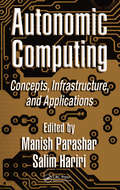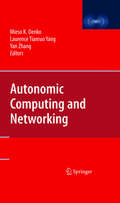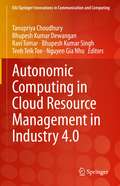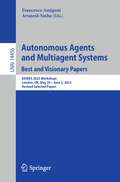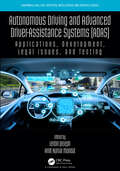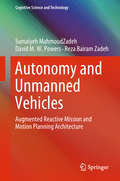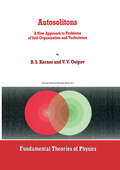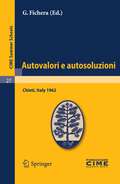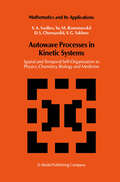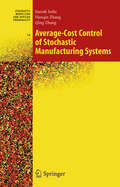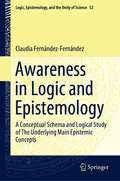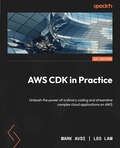- Table View
- List View
Autonomic Computing: Concepts, Infrastructure, and Applications
by Manish Parashar and Salim HaririThe complexity of modern computer networks and systems, combined with the extremely dynamic environments in which they operate, is beginning to outpace our ability to manage them. Taking yet another page from the biomimetics playbook, the autonomic computing paradigm mimics the human autonomic nervous system to free system developers and administrators from performing and overseeing low-level tasks. Surveying the current path toward this paradigm, Autonomic Computing: Concepts, Infrastructure, and Applications offers a comprehensive overview of state-of-the-art research and implementations in this emerging area.This book begins by introducing the concepts and requirements of autonomic computing and exploring the architectures required to implement such a system. The focus then shifts to the approaches and infrastructures, including control-based and recipe-based concepts, followed by enabling systems, technologies, and services proposed for achieving a set of "self-*" properties, including self-configuration, self-healing, self-optimization, and self-protection. In the final section, examples of real-world implementations reflect the potential of emerging autonomic systems, such as dynamic server allocation and runtime reconfiguration and repair.Collecting cutting-edge work and perspectives from leading experts, Autonomic Computing: Concepts, Infrastructure, and Applications reveals the progress made and outlines the future challenges still facing this exciting and dynamic field.
Autonomic Computing: Concepts, Infrastructure, and Applications
by Manish Parashar Salim HaririThe complexity of modern computer networks and systems, combined with the extremely dynamic environments in which they operate, is beginning to outpace our ability to manage them. Taking yet another page from the biomimetics playbook, the autonomic computing paradigm mimics the human autonomic nervous system to free system developers and administrators from performing and overseeing low-level tasks. Surveying the current path toward this paradigm, Autonomic Computing: Concepts, Infrastructure, and Applications offers a comprehensive overview of state-of-the-art research and implementations in this emerging area.This book begins by introducing the concepts and requirements of autonomic computing and exploring the architectures required to implement such a system. The focus then shifts to the approaches and infrastructures, including control-based and recipe-based concepts, followed by enabling systems, technologies, and services proposed for achieving a set of "self-*" properties, including self-configuration, self-healing, self-optimization, and self-protection. In the final section, examples of real-world implementations reflect the potential of emerging autonomic systems, such as dynamic server allocation and runtime reconfiguration and repair.Collecting cutting-edge work and perspectives from leading experts, Autonomic Computing: Concepts, Infrastructure, and Applications reveals the progress made and outlines the future challenges still facing this exciting and dynamic field.
Autonomic Computing and Networking
by Mieso Denko Laurence Tianruo Yang Yan ZhangAutonomic Computing and Networking presents introductory and advanced topics on autonomic computing and networking with emphasis on architectures, protocols, services, privacy & security, simulation and implementation testbeds. Autonomic computing and networking are new computing and networking paradigms that allow the creation of self-managing and self-controlling computing and networking environment using techniques such as distributed algorithms and context-awareness to dynamically control networking functions without human interventions. Autonomic networking is characterized by recovery from failures and malfunctions, agility to changing networking environment, self-optimization and self-awareness. The self-control and management features can help to overcome the growing complexity and heterogeneity of exiting communication networks and systems. The realization of fully autonomic heterogeneous networking introduces several research challenges in all aspects of computing and networking and related fields.
Autonomic Computing in Cloud Resource Management in Industry 4.0 (EAI/Springer Innovations in Communication and Computing)
by Tanupriya Choudhury Bhupesh Kumar Dewangan Ravi Tomar Bhupesh Kumar Singh Teoh Teik Toe Nguyen Gia NhuThis book describes the next generation of industry—Industry 4.0—and how it holds the promise of increased flexibility in manufacturing, along with automation, better quality, and improved productivity. The authors discuss how it thus enables companies to cope with the challenges of producing increasingly individualized products with a short lead-time to market and higher quality. The authors posit that intelligent cloud services and resource sharing play an important role in Industry 4.0 anticipated Fourth Industrial Revolution. This book serves the different issues and challenges in cloud resource management CRM techniques with proper propped solution for IT organizations. The book features chapters based on the characteristics of autonomic computing with its applicability in CRM. Each chapter features the techniques and analysis of each mechanism to make better resource management in cloud.
Autonomous Agents and Multiagent Systems. Best and Visionary Papers: AAMAS 2023 Workshops, London, UK, May 29 –June 2, 2023, Revised Selected Papers (Lecture Notes in Computer Science #14456)
by Francesco Amigoni Arunesh SinhaThis book contains visionary and best papers from the workshops held at the International Conference on Autonomous Agents and Multiagent Systems, AAMAS 2023, held in London, UK, during May 29–June 2, 2023.The 12 regular papers, 5 best papers and 7 visionary papers, presented were carefully reviewed and selected from a total of more than 110 contributions to the workshops. They focus on emerging topics and new trends in the area of autonomous agents and multiagent systems and stem from the following workshops:- Workshop on Autonomous Robots and Multirobot Systems (ARMS)- Workshop on Adaptive and Learning Agents (ALA)- Workshop on Interdisciplinary Design of Emotion Sensitive Agents (IDEA)- Workshop on Rebellion and Disobedience in Artificial Intelligence (RaD-AI)- Workshop on Neuro-symbolic AI for Agent and Multi-Agent Systems (NeSyMAS)- Workshop on Multiagent Sequential Decision Making under Uncertainty (MSDM)- Workshop on Citizen-Centric Multi-Agent Systems (C-MAS)
Autonomous Consumer Business
by Julian MorgenEine immer mehr digital vernetzte Welt führt zu einer sehr großen Menge von unterschiedlichen Daten, die in Echtzeit generiert werden („Big Data“). Ein großer Teil dieser Datenproduzenten sind Nutzer von Social Media oder auch smarten Geräten, wie bspw. Fitnesstrackern oder mit dem Internet verbundenen Waschmaschinen („IoT“). Unternehmen, die sich diese Daten aus der direkten Lebenswelt der Konsumenten zu Nutze machen, können sehr präzise Einblicke bspw. über Einstellungen, Verhalten oder auch die Bedürfnisse potenzieller Kunden erhalten, wodurch der Weg zu einer „automatisierten Vermarktung“ geebnet wird. Zielsetzung dieses Buches ist die Entwicklung eines Konzeptes für ein Autonomous Consumer Business (ACB), das als maximal eigenständig agierendes und durch Künstliche Intelligenz getragenes Geschäftsmodell verstanden wird, bei dem Unternehmen die Bedürfnisse auf der Konsumentenseite automatisch erkennen und durch entsprechende Leistungsangebote befriedigen können. Weiterhin werden zentrale Bestimmungsgrößen, welche die konsumentenseitige Inanspruchnahme eines ACB im besonderen Maße beeinflussen, sowie potenzielle Kundengruppen empirisch identifiziert, wodurch Hinweise zur konkreten Ausgestaltung eines ACB gewonnen werden können.
Autonomous Driving and Advanced Driver-Assistance Systems: Applications, Development, Legal Issues, and Testing (Chapman & Hall/CRC Artificial Intelligence and Robotics Series)
by Lentin JosephAutonomous Driving and Advanced Driver-Assistance Systems (ADAS): Applications, Development, Legal Issues, and Testing outlines the latest research related to autonomous cars and advanced driver-assistance systems, including the development, testing, and verification for real-time situations of sensor fusion, sensor placement, control algorithms, and computer vision. Features: Co-edited by an experienced roboticist and author and an experienced academic Addresses the legal aspect of autonomous driving and ADAS Presents the application of ADAS in autonomous vehicle parking systems With an infinite number of real-time possibilities that need to be addressed, the methods and the examples included in this book are a valuable source of information for academic and industrial researchers, automotive companies, and suppliers.
Autonomous Driving and Advanced Driver-Assistance Systems: Applications, Development, Legal Issues, and Testing (Chapman & Hall/CRC Artificial Intelligence and Robotics Series)
by Lentin Joseph Amit Kumar MondalAutonomous Driving and Advanced Driver-Assistance Systems (ADAS): Applications, Development, Legal Issues, and Testing outlines the latest research related to autonomous cars and advanced driver-assistance systems, including the development, testing, and verification for real-time situations of sensor fusion, sensor placement, control algorithms, and computer vision. Features: Co-edited by an experienced roboticist and author and an experienced academic Addresses the legal aspect of autonomous driving and ADAS Presents the application of ADAS in autonomous vehicle parking systems With an infinite number of real-time possibilities that need to be addressed, the methods and the examples included in this book are a valuable source of information for academic and industrial researchers, automotive companies, and suppliers.
Autonomy and Unmanned Vehicles: Augmented Reactive Mission and Motion Planning Architecture (Cognitive Science and Technology)
by Somaiyeh MahmoudZadeh David M.W. Powers Reza Bairam ZadehThis book addresses higher–lower level decision autonomy for autonomous vehicles, and discusses the addition of a novel architecture to cover both levels. The proposed framework’s performance and stability are subsequently investigated by employing different meta-heuristic algorithms. The performance of the proposed architecture is shown to be largely independent of the algorithms employed; the use of diverse algorithms (subjected to the real-time performance of the algorithm) does not negatively affect the system’s real-time performance. By analyzing the simulation results, the book demonstrates that the proposed model provides perfect mission timing and task management, while also guaranteeing secure deployment. Although mainly intended as a research work, the book’s review chapters and the new approaches developed here are also suitable for use in courses for advanced undergraduate or graduate students.
Autosolitons: A New Approach to Problems of Self-Organization and Turbulence (Fundamental Theories of Physics #61)
by B.S. Kerner V.V. OsipovThis monograph is devoted to an entirely new branch of nonlinear physics - solitary intrinsic states, or autosolitons, which form in a broad class of physical, chemical and biological dissipative systems. Autosolitons are often observed as highly nonequilibrium regions in slightly nonequilibrium systems, in many ways resembling ball lightning which occurs in the atmosphere. We develop a new approach to problems of self-organization and turbulence, treating these phenomena as a result of spontaneous formation and subsequent evolution of autosolitons. Scenarios of self-organization involve sophisticated interactions between autosolitons, whereas turbulence is regarded as a pattern of autosolitons which appear and disappear at random in different parts of the system. This monograph is the first attempt to provide a comprehensive summary of the theory of autosolitons as developed by the authors over the years of research. The monograph is comprised of three more or less autonomous parts. Part I deals with the physical nature and experimental studies of autosolitons and self organization in various physical systems: semiconductor and gas plasma, heated gas mixture, semiconductor structures, composite superconductors, optical and magnetic media, systems with uniformly generated combustion matter, distributed gas-discharge and electronic systems. We discuss feasibility of autosolitons in the form of highly nonequilibrium regions in slightly nonequilibrium gases and semiconductors, "hot" and "cold" regions in semiconductor and gas plasmas, static, pulsating and traveling combustion fronts.
Autovalori e autosoluzioni: Lectures given at a Summer School of the Centro Internazionale Matematico Estivo (C.I.M.E.) held in Chieti, Italy, August 1-9, 1962 (C.I.M.E. Summer Schools #27)
by G. FicheraS. Agmon: On eigenvalues, eigenfunctions, and resolvents of general elliptic problems.- A. Ostrowski: Il metodo del quoziente di Rayleigh.- L.E. Payne: Isoperimetric inequalities for eigenvalues and their applications.- L. De Vito: Calcolo degli autovalori e delle autosoluzioni per operatori non autoaggiunti.- L. De Vito: Sul calcolo per difetto e per eccesso degli autovalori delle trasformazioni compatte e delle relative molteplicità.- J.B. Diaz: Upper and lower bounds for the torsional rigidity and the capacity, derived from the inequality of Schwarz.- M. Schiffer: Fredholm eigenvalues and conformal mapping.
Autowave Processes in Kinetic Systems: Spatial and Temporal Self-Organisation in Physics, Chemistry, Biology, and Medicine (Mathematics and its Applications #11)
by V.A. Vasiliev Yu.M. Romanovskii D.S. Chernavskii V.G. YakhnoProbably, we are obliged to Science, more than to any other field of the human activity, for the origin of our sense that collective efforts are necessary indeed. F. Joliot-Curie The study of autowave processes is a young science. Its basic concepts and methods are still in the process of formation, and the field of its applications to various domains of natural sciences is expanding continuously. Spectacular examples of various autowave processes are observed experimentally in numerous laboratories of quite different orientations, dealing with investigations in physics, chemistry and biology. It is O1). r opinion, however, that if a history of the discovery of autowaves will he written some day its author should surely mention three fundamental phenomena which were the sources of the domain in view. "Ve mean combustion and phase transition waves, waves in chemical reactors where oxidation-reduction processes take place, and propagation of excitations in nerve fibres. The main tools of the theory of autowave processes are various methods used for investigating nonlinear discrete or distributed oscillating systems, the mathe matical theory of nonlinear parabolic differential equations, and methods of the theory of finite automata. It is noteworthy that the theory of autowave,. , has been greatly contributed to be work of brilliant mathematicians who anticipated the experimental discoveries in their abstract studies. One should mention R. Fishel' (1937), A. N. Kolmogorov, G. 1. Petrovskii, and N. S. Piskunov (1937), N. Wiener and A. Rosenbluth (1946), A. Turing (1952).
Auxiliary Signal Design for Failure Detection (PDF)
by Stephen L. Campbell Ramine NikoukhahMany industries, such as transportation and manufacturing, use control systems to insure that parameters such as temperature or altitude behave in a desirable way over time. For example, pilots need assurance that the plane they are flying will maintain a particular heading. An integral part of control systems is a mechanism for failure detection to insure safety and reliability. This book offers an alternative failure detection approach that addresses two of the fundamental problems in the safe and efficient operation of modern control systems: failure detection--deciding when a failure has occurred--and model identification--deciding which kind of failure has occurred. Much of the work in both categories has been based on statistical methods and under the assumption that a given system was monitored passively. Campbell and Nikoukhah's book proposes an "active" multimodel approach. It calls for applying an auxiliary signal that will affect the output so that it can be used to easily determine if there has been a failure and what type of failure it is. This auxiliary signal must be kept small, and often brief in duration, in order not to interfere with system performance and to ensure timely detection of the failure. The approach is robust and uses tools from robust control theory. Unlike some approaches, it is applicable to complex systems. The authors present the theory in a rigorous and intuitive manner and provide practical algorithms for implementation of the procedures.
Average Case Analysis of Algorithms on Sequences (Wiley Series in Discrete Mathematics and Optimization #50)
by Wojciech SzpankowskiA timely book on a topic that has witnessed a surge of interest over the last decade, owing in part to several novel applications, most notably in data compression and computational molecular biology. It describes methods employed in average case analysis of algorithms, combining both analytical and probabilistic tools in a single volume. * Tools are illustrated through problems on words with applications to molecular biology, data compression, security, and pattern matching. * Includes chapters on algorithms and data structures on words, probabilistic and analytical models, inclusion-exclusion principles, first and second moment methods, subadditive ergodic theorem and large deviations, elements of information theory, generating functions, complex asymptotic methods, Mellin transform and its applications, and analytic poissonization and depoissonization. * Written by an established researcher with a strong international reputation in the field.
Average-Case Analysis of Numerical Problems (Lecture Notes in Mathematics #1733)
by Klaus RitterThe average-case analysis of numerical problems is the counterpart of the more traditional worst-case approach. The analysis of average error and cost leads to new insight on numerical problems as well as to new algorithms. The book provides a survey of results that were mainly obtained during the last 10 years and also contains new results. The problems under consideration include approximation/optimal recovery and numerical integration of univariate and multivariate functions as well as zero-finding and global optimization. Background material, e.g. on reproducing kernel Hilbert spaces and random fields, is provided.
Average-Cost Control of Stochastic Manufacturing Systems (Stochastic Modelling and Applied Probability #54)
by Suresh P. Sethi Han-Qin Zhang Qing ZhangThis book articulates a new theory that shows that hierarchical decision making can in fact lead to a near optimization of system goals. The material in the book cuts across disciplines. It will appeal to graduate students and researchers in applied mathematics, operations management, operations research, and system and control theory.
Averaging Methods in Nonlinear Dynamical Systems (Applied Mathematical Sciences #59)
by Jan A. Sanders Ferdinand VerhulstIn this book we have developed the asymptotic analysis of nonlinear dynamical systems. We have collected a large number of results, scattered throughout the literature and presented them in a way to illustrate both the underlying common theme, as well as the diversity of problems and solutions. While most of the results are known in the literature, we added new material which we hope will also be of interest to the specialists in this field. The basic theory is discussed in chapters two and three. Improved results are obtained in chapter four in the case of stable limit sets. In chapter five we treat averaging over several angles; here the theory is less standardized, and even in our simplified approach we encounter many open problems. Chapter six deals with the definition of normal form. After making the somewhat philosophical point as to what the right definition should look like, we derive the second order normal form in the Hamiltonian case, using the classical method of generating functions. In chapter seven we treat Hamiltonian systems. The resonances in two degrees of freedom are almost completely analyzed, while we give a survey of results obtained for three degrees of freedom systems. The appendices contain a mix of elementary results, expansions on the theory and research problems.
Averaging Methods in Nonlinear Dynamical Systems (Applied Mathematical Sciences #59)
by Jan A. Sanders Ferdinand Verhulst James MurdockPerturbation theory and in particular normal form theory has shown strong growth in recent decades. This book is a drastic revision of the first edition of the averaging book. The updated chapters represent new insights in averaging, in particular its relation with dynamical systems and the theory of normal forms. Also new are survey appendices on invariant manifolds. One of the most striking features of the book is the collection of examples, which range from the very simple to some that are elaborate, realistic, and of considerable practical importance. Most of them are presented in careful detail and are illustrated with illuminating diagrams.
Awareness in Logic and Epistemology: A Conceptual Schema and Logical Study of The Underlying Main Epistemic Concepts (Logic, Epistemology, and the Unity of Science #52)
by Claudia Fernández-FernándezThis book creates a conceptual schema that acts as a correlation between Epistemology and Epistemic Logic. It connects both fields and offers a proper theoretical foundation for the contemporary developments of Epistemic Logic regarding the dynamics of information. It builds a bridge between the view of Awareness Justification Internalism, and a dynamic approach to Awareness Logic. The book starts with an introduction to the main topics in Epistemic Logic and Epistemology and reviews the disconnection between the two fields. It analyses three core notions representing the basic structure of the conceptual schema: “Epistemic Awareness”, “Knowledge” and “Justification”. Next, it presents the Explicit Aware Knowledge (EAK) Schema, using a diagram of three ellipses to illustrate the schema, and a formal model based on a neighbourhood-model structure, that shows one concrete application of the EAK-Schema into a logical structure. The book ends by presenting conclusions and final remarks about the uses and applications of the EAK-Schema. It shows that the most important feature of the schema is that it serves both as a theoretical correlate to the dynamic extensions of Awareness Logic, providing it with a philosophical background, and as an abstract conceptual structure for a re-interpretation of Epistemology.
Awesome Games and Activities for Kids with Numeracy Difficulties: How to Feel Smart and In Control about Doing Mathematics with a Neurodiverse Brain
by Judy HornigoldHas maths ever made you feel anxious, confused or like you just don't get it? This is an entertaining collection of mathematical games and curiosities for you to astound your family and friends with. You don't have to follow the chapters in a certain order - you can use this book however you would like, whether you want to get creative, play a game or impress your friends with a clever trick.Designed to spark a child's enthusiasm for maths and make learning simple, this book will help children to grasp the fundamental concepts in maths through exploration and play. This book will appeal to all learning styles and abilities but is particularly relevant for those with specific learning difficulties such as dyscalculia. Building self-esteem and promoting a growth mindset, these activities will help readers to effortlessly develop their number skills, empowering even the least confident learner with a deeper understanding of maths.
Awesome Math: Teaching Mathematics with Problem Based Learning
by Titu Andreescu Kathy Cordeiro Alina AndreescuHelp your students to think critically and creatively through team-based problem solving instead of focusing on testing and outcomes. Professionals throughout the education system are recognizing that standardized testing is holding students back. Schools tend to view children as outcomes rather than as individuals who require guidance on thinking critically and creatively. Awesome Math focuses on team-based problem solving to teach discrete mathematics, a subject essential for success in the STEM careers of the future. Built on the increasingly popular growth mindset, this timely book emphasizes a problem-solving approach for developing the skills necessary to think critically, creatively, and collaboratively. In its current form, math education is a series of exercises: straightforward problems with easily-obtained answers. Problem solving, however, involves multiple creative approaches to solving meaningful and interesting problems. The authors, co-founders of the multi-layered educational organization AwesomeMath, have developed an innovative approach to teaching mathematics that will enable educators to: Move their students beyond the calculus trap to study the areas of mathematics most of them will need in the modern world Show students how problem solving will help them achieve their educational and career goals and form lifelong communities of support and collaboration Encourage and reinforce curiosity, critical thinking, and creativity in their students Get students into the growth mindset, coach math teams, and make math fun again Create lesson plans built on problem based learning and identify and develop educational resources in their schools Awesome Math: Teaching Mathematics with Problem Based Learning is a must-have resource for general education teachers and math specialists in grades 6 to 12, and resource specialists, special education teachers, elementary educators, and other primary education professionals.
Awesome Math: Teaching Mathematics with Problem Based Learning
by Titu Andreescu Kathy Cordeiro Alina AndreescuHelp your students to think critically and creatively through team-based problem solving instead of focusing on testing and outcomes. Professionals throughout the education system are recognizing that standardized testing is holding students back. Schools tend to view children as outcomes rather than as individuals who require guidance on thinking critically and creatively. Awesome Math focuses on team-based problem solving to teach discrete mathematics, a subject essential for success in the STEM careers of the future. Built on the increasingly popular growth mindset, this timely book emphasizes a problem-solving approach for developing the skills necessary to think critically, creatively, and collaboratively. In its current form, math education is a series of exercises: straightforward problems with easily-obtained answers. Problem solving, however, involves multiple creative approaches to solving meaningful and interesting problems. The authors, co-founders of the multi-layered educational organization AwesomeMath, have developed an innovative approach to teaching mathematics that will enable educators to: Move their students beyond the calculus trap to study the areas of mathematics most of them will need in the modern world Show students how problem solving will help them achieve their educational and career goals and form lifelong communities of support and collaboration Encourage and reinforce curiosity, critical thinking, and creativity in their students Get students into the growth mindset, coach math teams, and make math fun again Create lesson plans built on problem based learning and identify and develop educational resources in their schools Awesome Math: Teaching Mathematics with Problem Based Learning is a must-have resource for general education teachers and math specialists in grades 6 to 12, and resource specialists, special education teachers, elementary educators, and other primary education professionals.
Aws Cdk In Practice: Streamline Building Complex Cloud Applications On Aws By Unleashing The Power Of Ordinary Coding
by Mark Avdi Leo LamAWS CDK in Practice: Streamline Building Complex Cloud Applications On Aws By Unleashing The Power Of Ordinary Coding
by Mark Avdi | Leo LamUnleash the power of ordinary coding and streamline complex cloud applications on AWS
